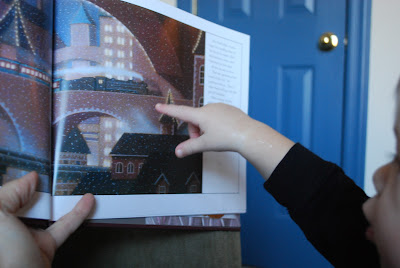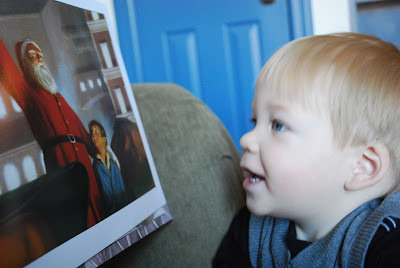The Polar Express is a favorite book of mine, yes book, it started as a book! It is such a special book that I wanted to start a tradition where we read this story every year. I knew that the story was not a 'toddler' story and that keeping Jacob's interest during the story could be tricky.
I picked up some bells from the Dollar Tree to help tell the story and keep his interest.
I started by showing Jake the book cover with a train on it. (Knew that would help hook him) I also pointed out the falling snow. It snowed here last weekend and he was able to enjoy the new weather condition. He is very excited by snow!
Jake stayed engaged for the first few pages. He enjoyed pointing out items that he recognized: snow, train, moon, lights. I did not show him the bells, I kept them behind me so that would be excited when I introduced them.
He did lose interest and run off to the Sensory Box. But I continued reading. It is important to allow them to come and go. A toddler can not sit still and listen to long stories and stay engaged. Allowing them to move around and multi-task helps them stay engaged.
Just because they get up and go does not mean they are not still listening.
But he came back and was very excited to see Santa! Using the bells helped! The amazing part was that while I shook the bell behind the book he never looked for it! (Ah the innocence of being a small child!) It was as if he could hear the bells in the story! How magical! When Santa handed over the bell, I gave Jacob a bell.
What an amazing first experience with The Polar Express!
After we finished the story together, Jacob went on to 'read' it on his own!
I hope you are enjoying Holiday books as well!










Comments
Post a Comment